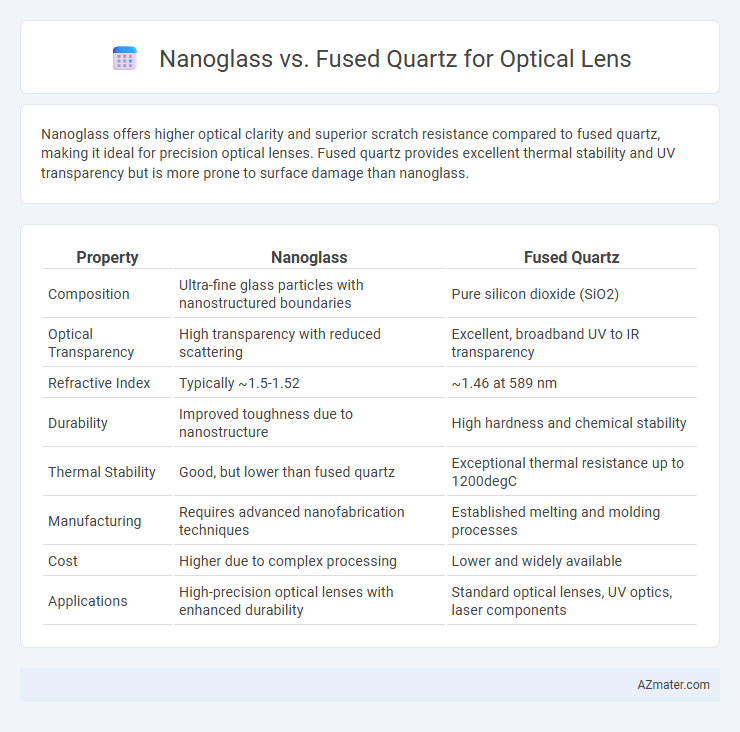Nanoglass offers higher optical clarity and superior scratch resistance compared to fused quartz, making it ideal for precision optical lenses. Fused quartz provides excellent thermal stability and UV transparency but is more prone to surface damage than nanoglass.
Table of Comparison
| Property | Nanoglass | Fused Quartz |
|---|---|---|
| Composition | Ultra-fine glass particles with nanostructured boundaries | Pure silicon dioxide (SiO2) |
| Optical Transparency | High transparency with reduced scattering | Excellent, broadband UV to IR transparency |
| Refractive Index | Typically ~1.5-1.52 | ~1.46 at 589 nm |
| Durability | Improved toughness due to nanostructure | High hardness and chemical stability |
| Thermal Stability | Good, but lower than fused quartz | Exceptional thermal resistance up to 1200degC |
| Manufacturing | Requires advanced nanofabrication techniques | Established melting and molding processes |
| Cost | Higher due to complex processing | Lower and widely available |
| Applications | High-precision optical lenses with enhanced durability | Standard optical lenses, UV optics, laser components |
Introduction to Optical Lens Materials
Nanoglass and fused quartz are critical materials in optical lens manufacturing due to their distinct properties. Nanoglass offers superior hardness, high thermal stability, and excellent transparency in the UV to visible spectrum, making it ideal for precision optics requiring durability and minimal light distortion. Fused quartz provides exceptional UV transmission, low thermal expansion, and chemical inertness, widely used in applications demanding high optical clarity and resistance to harsh environments.
What is Nanoglass?
Nanoglass is an advanced material composed of nanoscale glass particles that exhibit superior optical clarity and enhanced mechanical strength compared to traditional fused quartz. Its unique nanostructure allows for improved light transmission, reduced scattering, and greater resistance to thermal stress, making it ideal for precision optical lenses. Unlike fused quartz, Nanoglass offers enhanced durability and performance in high-precision applications such as microscopy, laser systems, and advanced imaging technologies.
What is Fused Quartz?
Fused quartz is a high-purity, synthetic silica glass known for its exceptional optical clarity, low thermal expansion, and high resistance to thermal shock, making it ideal for precision optical lenses. Unlike traditional glass, fused quartz is produced by melting high-purity silica sand, ensuring minimal impurities and superior ultraviolet transmittance. Its durability and stable optical properties under extreme conditions distinguish it from other materials like Nanoglass in applications requiring reliable lens performance.
Optical Clarity: Nanoglass vs Fused Quartz
Nanoglass offers superior optical clarity compared to fused quartz due to its higher purity and reduced light scattering, resulting in enhanced transparency across a broad wavelength range. Fused quartz, while offering excellent UV transmission and thermal stability, exhibits slightly more inclusions and internal scattering that can diminish clarity in precision optical applications. The enhanced homogeneity and low birefringence of nanoglass make it preferable for high-resolution imaging and laser optics requiring pristine clarity.
Durability and Strength Comparison
Nanoglass optical lenses exhibit higher scratch resistance and improved durability compared to fused quartz due to their enhanced nano-scale structure, providing superior impact resistance and lifespan in demanding environments. Fused quartz, while offering excellent thermal stability and chemical inertness, tends to be more brittle and susceptible to cracking under mechanical stress. The advanced hardness and fracture toughness of nanoglass materials make them a preferred choice for applications requiring robust optical performance and long-term reliability.
Light Transmission Efficiency
Nanoglass exhibits superior light transmission efficiency compared to fused quartz due to its engineered nanostructure that reduces scattering and absorption at visible wavelengths. While fused quartz offers high purity and UV transmission up to 200 nm, nanoglass materials can achieve transmission rates exceeding 95% across a broader spectral range, enhancing optical clarity and brightness. The advanced nanoglass also minimizes surface reflection losses, making it ideal for high-performance optical lenses demanding maximum light throughput.
Thermal and Chemical Resistance
Nanoglass exhibits superior thermal resistance compared to fused quartz, maintaining structural integrity at temperatures exceeding 1,200degC, making it ideal for high-temperature optical applications. Chemically, nanoglass resists alkali and acid corrosion more effectively than fused quartz, which can be prone to surface etching in aggressive environments. This enhanced thermal and chemical resilience positions nanoglass as a durable choice for optical lenses subjected to extreme operating conditions.
Cost and Availability
Nanoglass lenses typically offer a cost-effective alternative to fused quartz due to lower manufacturing expenses and material costs, making them more accessible for mass production. Fused quartz, while more expensive, provides superior thermal stability and durability, but its availability is limited by complex fabrication processes and sourcing of high-purity raw materials. For optical applications prioritizing budget and supply, nanoglass presents a viable option, whereas fused quartz remains the preferred choice for high-precision lenses requiring long-term reliability.
Applications in Optics and Photonics
Nanoglass exhibits superior optical clarity and enhanced mechanical strength compared to fused quartz, making it ideal for high-performance laser systems and precision photonic devices. Its lower thermal expansion coefficient and improved resistance to radiation damage ensure stability in extreme environments, benefiting applications in aerospace optics and UV lithography. Fused quartz remains preferred in cost-sensitive scenarios due to its excellent UV transmission and chemical inertness, commonly used in spectrometry and fiber optic components.
Conclusion: Choosing the Right Material for Optical Lenses
Nanoglass offers advantages over fused quartz in optical lenses by providing higher transparency, superior scratch resistance, and better durability, making it ideal for demanding environments. Fused quartz remains valuable for its exceptional thermal stability and low thermal expansion, essential in high-precision applications. Selecting the right material depends on balancing the requirements for optical clarity, mechanical strength, and environmental resilience to optimize lens performance.

Infographic: Nanoglass vs Fused quartz for Optical lens
 azmater.com
azmater.com